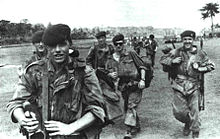Para-Commando Brigade
This article needs additional citations for verification. (January 2013) |
| Paracommando Regiment (1952-1991) Paracommando Brigade (1991-2003) Light Brigade (2003-2018) Special Operations Regiment (2018-present) | |
|---|---|
Special operations forces | |
| Role | Primary missions
Other roles |
| Part of | Brigade |
| Garrison/HQ | ISAF |
| Commanders | |
| Current commander | Colonel Tom Bilo |
The Para-Commando Brigade was an
History
During the
In 1952, these parachutist and commando units were brought together in a Para-Commando Regiment. Later, an
In 2018, the Light Brigade was transformed into the Special Operations Regiment. The regiment consists of the two remaining Para-Commando battalions (3Para, 2Commando), the Special Forces Group (Belgium), a support unit of the Communication & Information Systems Group, the training centre for Parachutists and the training centre for Commandos. The 12/13th Battalion of the Line was transferred to the Motorized Brigade (Belgium).
The Paracommando battalions work closely with the
Operations in Africa
From 1953, the commandos participated actively in the "African period"[
Congo
The regiment saw repeated action during the Congo Crisis of the 1960s. In July 1960, 3,000 para-commandos and five independent reserve companies intervened in a number of Congolese cities to facilitate the evacuation of Europeans and the disarmament of Armee Nationale Congolaise mutineers.

The
On 24 November 1964, with the
The regiment later saw action at Kolwezi during Shaba II in 1978, where they evacuated about 2,000 expats and took part in the Battle of Kolwezi to liberate the city from rebels. They also evacuated European citizens during Operation Blue Beam in September 1991, and during Operation Green Stream in March 1997.
Somalia

From 1992 to 1993, all three battalions were deployed to Somalia as part of
Other operations
In late November, 1985, around 1,000 Paracommandos comprising six companies of the 2nd Commando and 3rd Parachute Battalions[5] were deployed to man static and mobile security posts around government buildings in Brussels, amidst a then-ongoing terrorist campaign by the Far-left Communist Combatant Cells (this being during a relatively violent period of militant and criminal activity in Belgian history; Les Années de plomb). The group had raided a Belgian Army barracks and stolen battle rifles, wounded a soldier, killed two firemen and wounded 13 civilians in a series of attacks. Concerns also arose due to an upcoming visit by US President Ronald Reagan.[6]
Elements of the 3rd Para Battalion were deployed to Iran in 1991 to help
Elements of the Brigade have also been deployed to Kosovo as part of
Reformation 2003

Previously known as Paracommando Brigade, the Light Brigade had grouped all personnel into three airborne infantry battalions, except for the independent support units that are typically part of a brigade structure. These support units were re-attached to regular battalions, but retained some airborne capacity. The Light Brigade had its headquarters in Heverlee. The three remaining airborne infantry battalions were located as follows:
- 1 Paratroop Battalion in Diest(disbanded on 1 July 2011 and its two companies distributed between the other two battalions)
- 2nd Commando Battalion in Flawinne
- 3rd Parachute Battalion in Tielen
The 2nd and 3rd battalion currently exist within the Light Brigade. Although these battalions refer to themselves as either commando or paratroopers, recruits have received the same training and perform the same duties. Individual battalion traditions cause units to have different designators, beret colours and insignia. 2nd Commando Battalion wear green berets in reference to their connection to the 4th (Belgian) Troop of No.10 Commando.[7] 3rd Parachute Battalion wear maroon berets.
Reformation 2018
On 3 July 2018, the Light Brigade was renamed and transformed into the Special Operations Regiment.
Notes and references
- ^ http://www.specialoperations.com/Foreign/Belgium/Para_Commandos/default.htm Archived 2011-06-29 at the Wayback Machine, accessed July 2009
- ^ Commando Museum, 1953-62: The African Period
- ^ "TheHistoryNet | 20th - 21st Century | Congo Crisis: Operation Dragon Rouge". Archived from the original on March 16, 2008. Retrieved February 16, 2013.
- ^ Dragon Operations: Hostage Rescues in the Congo, 1964–1965 Archived 2008-06-21 at the Wayback Machine, Maj. T. Odom, Combat Studies Institute, accessed January 2009
- ^ https://www.youtube.com/watch?v=JNi7LiQyEwM 39:37
- ^ Miller, Judith (24 November 1985). "Belgium is Shaken by Bombs and 'Crazy Killers'". The New York Times.
- ^ "Composante Terre". Belgian Defence (in French). Retrieved 22 August 2017.
